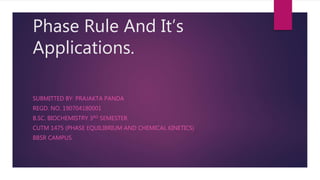
Phase rule and it's applications
- 1. Phase Rule And It’s Applications. SUBMITTED BY: PRAJAKTA PANDA REGD. NO. 190704180001 B.SC. BIOCHEMISTRY 3RD SEMESTER CUTM 1475 (PHASE EQUILIBRIUM AND CHEMICAL KINETICS) BBSR CAMPUS
- 2. CONTENTS: PHASE OF A SYSTEM COMPONENTS OF A SYSTEM DEGREES OF FREEDOM GIBBS PHASE RULE APPLICATIONS OF PHASE RULE IT‘S ADVANTAGES IT‘S LIMITATIONS
- 3. PHASE OF A SYSTEM Phase is a homogenous, physically distinct and mechanically separable part of a system and is in dynamic equilibrium with other parts of the system. A system containing water and it’s vapour is a two-phase system. An equilibrium mixture of ice (solid form of water), liquid water and water vapour is a three phase system. A phase may be gas, solid or liquid.
- 4. COMPONENTS OF A SYSTEM Component is “the smallest number of independent variable constituents, taking part in state of equilibrium, by mean of which the composition of each phase can be expressed in the form of chemical equation”. C= N – E, where, C= No. of components N= No. Of constituents present in a system E= relation between them In the water system, the chemical composition of all the three phases is H2O. Hence, it is one component system. The sulphur system consists of four phases, rhombic, monoclinic, liquid and vapour, the chemical composition of all phases is S. Hence, it is one component system.
- 5. DEGREE OF FREEDOM The minimum number of independently variable factors, such as temperature, pressure and composition of the phases, which must be arbitrarily specified in order to represent perfectly the condition of a system is known as the degree of freedom of a system. In case of water system, three phases are present in equilibrium, then no condition need to be specified, as the three phases can be in equilibrium only at particular temperature and pressure. If condition (e.g. Temperature or pressure) is altered, three phases will not remain in equilibrium and one of the phase disappears. For a system consisting of water in contact with its vapour, we must state either the temperature or pressure to define it completely. Hence, degree of freedom is one or system is univariant. For a system consisting of water vapour phase only, we must the values of both the temperature and pressure in order to describe the system completely. Hence, the system is bivariant or has two degrees of freedom.
- 6. GIBBS PHASE RULE The Gibbs phase rule identifies the degree of freedom of a multiphase system that is in thermodynamic equilibrium. It relates the number of intensive independent thermodynamic properties for each phase and the number of phases for a system. F = C – P + 2 where, F= Degree of freedom C= No. of chemical components P= No. of phases in a system
- 7. APPLICATIONS OF PHASE RULE. It is used in safety plugs which is used in buildings and also in the wires of pressure cooker. These plugs melt down and prevent the fire during an accident. Also used in solder. Used in freeze drying. This is a technique of dehydration of food in pharmaceutical industries.
- 8. ADVANTAGES OF PHASE RULE It is applicable to both physical and chemical equilibria. It require no information regarding molecular/ micro-structure, since it is applicable to macroscopic system. It is a convenient method of classifying equilibrium states in terms of phases, components and degrees of freedom. It helps us to predict the behaviour of a system, under different sets of variables. It indicates that different systems with same degree of freedom behave similarly. It helps in deciding whether under a given set of condition: a. Various substances would exist together in equilibrium b. Some of the substances present would be interconverted c. Some of the substances present would be eliminated
- 9. LIMITATIONS OF PHASE RULE It can be applied only for system in equilibrium. Consequently, it is of little value in case of very slow equilibrium state attaining system. It applies only to a single equilibrium system and provided no information regarding any other possible equilibria in the system. It requires utmost care in deciding the number of phases existing in an equilibrium sate, since it considers only the number of phases, rather than their amounts. Thus, even if a trace of the phase is present, it accounts towards the total number of phases. It conditions that all phases of the system must be present simultaneously, under the identical conditions of temperature and pressure. It conditions that solid and liquid phases must not be in finely –divided state; otherwise deviations occurs.
- 10. THANK YOU!